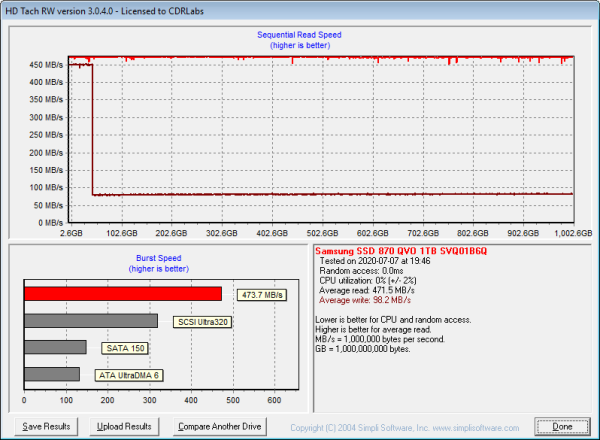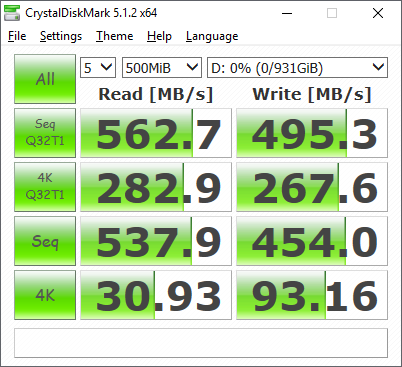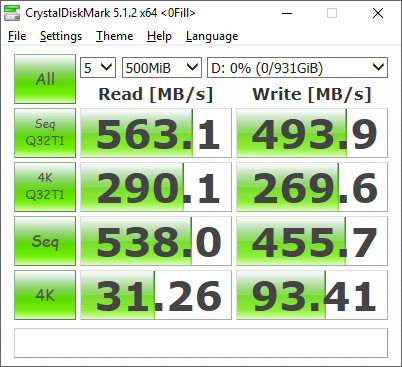The test system used in this review is equipped with an Intel Core i7-6700K CPU, GIGABYTE GA-Z170X-UD3 motherboard, 32GB (16GB x 2) of Crucial Ballistix Sport LT DDR4 memory, Samsung 960 PRO 512GB SSD and a GIGABYTE GeForce GTX 1060 WINDFORCE OC 6G graphics card. For the operating system, I installed a fresh copy of Windows 10 Enterprise.
To test the performance of Samsung's 870 QVO SSD, I ran a series of benchmarks using CrystalDiskMark, HD Tach RW, ATTO Disk Benchmark, AS SSD, HD Tune Pro, Anvil's Storage Utilities, Iometer and PCMark 8. For comparison, I've also included test results from the SK hynix Gold S31, ADATA Ultimate SU750, Samsung 860 QVO, Samsung 860 PRO, Crucial MX500, Plextor M8V, Crucial BX300, ADATA Ultimate SU900, Plextor S3C, Toshiba OCZ VX500, ADATA Ultimate SU800, Plextor S2C, Crucial MX300, Plextor M7V, PNY CS1311, OCZ Trion 150, PNY CS2211, Plextor M6V, Crucial BX200, OCZ Trion 100, Kingston HyperX Savage, Crucial MX200, OCZ Vector 180, Kingston BX100, Samsung 850 EVO M.2, Samsung 850 EVO mSATA, AMD Radeon R7, Silicon Power Slim S80, Samsung SSD 850 EVO, OCZ ARC 100, SanDisk Ultra II, Crucial MX100, SanDisk Extreme Pro and Samsung SSD 850 PRO.

As I mentioned earlier, the 870 QVO uses Samsung's MKX controller chip. Looking at the screenshot above, you can see that it performs equally well with both incompressible (0%) and compressible (100%) data.
CrystalDiskMark 5.1.2:
First, I ran a few quick tests using CrystalDiskMark. This benchmark tool measures the performance of a storage device by testing its sequential read and write speeds as well as its random read and write speeds using blocks 512K and 4K in size.
According to Samsung, the 870 QVO is capable of reading at 560 MB/s and writing at 530 MB/s. Looking at the screenshot above, you can see that the drive had no problems reaching these speeds in CrystalDiskMark's sequential read and write tests.
The 870 QVO performed equally well when using highly compressible 0x00 (0 Fill) data. This time around, the drive was able to read at 562.7 MB/s and write at 533.0 MB/s.
HD Tach RW 3.0.4.0:
Next, I used HD Tach to test the 870 QVO's read, write and burst speeds as well as its seek times and CPU usage.

Looking at the screenshot above, you can see that the 870 QVO had average read and write speeds of 471.5 MB/s and 98.2 MB/s respectively, as well as a burst speed of 473.7 MB/s. The screenshot also shows the transition from TurboWrite to what Samsung calls "After TurboWrite" speeds. The 870 QVO starts writing at about 450 MB/s and then drops to about 80 MB/s when the consecutive write operation exceeds the size of the SLC buffer.
ATTO Disk Benchmark 2.46:
I also used ATTO Disk Benchmark to test the 870 QVO's sequential read and write speeds. The tests are run using blocks ranging in size from 0.5KB to 8192KB and the total length set to 256MB.
When tested with ATTO, the 870 QVO's read speeds topped out at about 557 MB/s and its write speeds at 522 MB/s.







